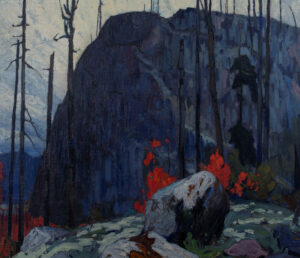When I stepped foot into the exhibit space of Generations: The Sobey Family and Canadian Art, I immediately became immersed in a powerfully emotive and reflective world of cultural exploration.
Generations is a curated exhibition of the Sobey family’s personal art collection. Hailing from Nova Scotia, they’re best known as the founders of the Sobeys grocery chain—however, for four generations they’ve also amassed an impressive collection of Canadian art that has been travelling across the country and has arrived at the Art Gallery of Greater Victoria (AGGV).
Generations captures an exploration of what it means to be “Canadian,” and the many tensions within the history of Canadian identity. Through landscapes, daily life, and other cultural expressions, the exhibition develops the effect of an iceberg: what you see on the outside is only a glimpse of what lies within. With the help of excellent lighting and well-planned flow, Generations did the job of an art gallery environment well by strongly facilitating the art encapsulating the viewer. This allowed me to look deeper into the works individually and as a collective and understand the depth curators were conveying using the purposeful juxtaposition of European settler descendent art and Indigenous art to explore what Canada is.

Clarence Gagnon’s Winter Landscape, Baie St. Paul and the famous Group of Seven’s work serve as homages to Canadian landscapes; there’s also various scenes of European descendent culture, such as the Toronto streets in Lawren Harris’ painting Sketch in the Ward. European modernist influence can be strongly felt in the Group of Seven’s work, such as J.E.H. MacDonald’s Morning Light, Lake O’Hara, and AY Jackson’s Northern Landscape, Great Bear Lake. They’re installed near Joseph Tisiga’s piece Fabricated Fear May Only Prolong Risk, which demonstrates the relationship of settlers with the land in a direct confrontation between a man and a decapitated bear. It evokes the feeling that the land is keeping score as an omniscient presence, and that the laws of nature have been broken.
The exhibition claims to be in the style of art collecting itself—eclectic, drawing new connections between different artists, and defying segregation of art movements. After my visit, I would absolutely agree. Generations also notes the exhibition is “artist food for the soul from the Sobey family pantry,” but I think it’s more complex than that. By the time I reached the final room of the exhibition, my many thoughts, feelings, and ideas all became clear.
The last room of Generations was intense, directly highlighting the tensions between European settler colonial culture and Indigenous culture, with Kent Monkman’s work directly taking this tension on.
Erotic, comedic, and deathly serious, the subject matter intensely highlights the historical tension between European colonial settlers and Indigenous peoples. It is the epitome of the exhibition, and being saved for last, it is explosive. People were crowding around each massive painting to talk, unravelling the many threads of the jumbled, knotted mess that Monkman ties together using exaggerated, dream-like symbolism.
Monkman’s subject matter is juxtaposed with nearby paintings of lighthouses and ships on the Atlantic, William Kurelek’s easter basket painting, Cornelius Krieghoff’s early Canadian sugar-coated “rural life” paintings, and Sobey art award winner Ursula Johnson’s Museological Grand Hall installation.
My experience at the exhibit was incredible. This is certainly one to spend hours in, giving it the attention it deserves. It really is a collection that needs to be seen, and it benefits from careful curation, to elevate it as a marker of culture and the way we see it. Catch Generations before the exhibit closes at the AGGV—and give yourself time to take it in.
Generations: The Sobey Family and Canadian Art
Until Sunday, October 27
Art Gallery of Greater Victoria
aggv.ca
